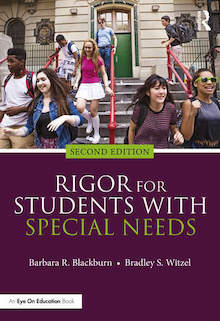Neurodivergent Students Will Benefit from Rigor
Rigor for Students with Special Needs, 2nd Edition
By Barbara R. Blackburn and Bradley S. Witzel
(Routledge/Eye on Education, 2022 – Learn more)
Reviewed by Andrea Bergener

It was still extremely valuable information and I would especially recommend it to new and veteran classroom teachers, particularly those who may not have had the experience of teaching neurodivergent students or studying their needs in depth.
Many of the strategies presented are solid teaching practices that would benefit all learners in a classroom.
 What’s in the book
What’s in the book
The book begins by presenting and refuting common myths surrounding students with special needs, which sets the stage for the authors’ premise that all students are capable of meaningful learning in the different content areas.
The next chapters model the practice of utilizing various forms of assessment and then using that data for planning effective instruction and meeting rigorous expectations for their learning.
There are specific chapters dedicated to literacy and math instruction, but throughout the book the authors also include examples for science and social studies classes at a variety of grade levels.
There are many helpful graphic organizers illustrating these examples, but I wish there was a companion website where these could be downloaded for immediate use.
The final chapter addresses teacher concerns and challenges with student motivation, parent involvement, remote learning, writing and meeting IEP (Individual Education Programs) requirements.
Zeroing in on a content area
As a math specialist, I paid special attention to the chapter on math strategies. It begins with understanding the name and quantity associated with numerals, then moves to magnitude comparisons, counting, and computation. One strategy highlighted for fact retention was Cover-Copy-Compare, which I immediately used to help some third graders with their multiplication facts. It was effective and enjoyable for the students!
The math chapter also referenced a favorite book of mine by Anita Archer and Charles Hughes on explicit instruction and includes a helpful checklist for planning and observing instruction. The chapter includes examples of the Concrete Visual (Representational) Abstract sequence of instruction, which I use on a daily basis with my students. Application of Universal Design for Learning (UDL), differentiation, and solving word problems were also included.
While the authors include examples and references that cite research-proven practices, the tone of the book is straightforward and easy to understand and apply to a variety of teaching situations. There is a guide at the end for using this book in a PLC or book study. It’s a book well worth adding to your professional library.
Andrea Bergener is the math specialist at Prince of Peace Catholic School in Plano, TX. She has nearly 20 years of experience in education as a classroom teacher, interventionist, instructional coach, and tutor. She earned her BS in Elementary Education from the University of Nebraska-Lincoln and MA in Teaching (Science Education) from the University of Texas-Dallas.
Andrea recently completed the graduate Program for Inclusive Education from the University of Notre Dame. She is particularly interested in providing equal opportunities in Catholic schools for neurodivergent students and developing all students’ confidence and success in mathematics.




































This article highlights the importance of providing rigor in education for neurodivergent students. It emphasizes that challenging and engaging educational experiences can benefit all learners, including those with diverse needs. Kudos to the author for advocating for inclusive and supportive learning environments!